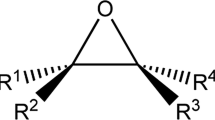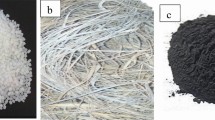Abstract
The present work deals with effect of coupling agent on banana fiber-reinforced polypropylene (PP) composites. Banana fiber-reinforced polypropylene composites were prepared using twin screw extruder with coupling agent and also without coupling agent. The mechanical properties of coupled composites like tensile, flexural and impact strength revealed significant enhancement compared to the uncoupled composites. The failure of uncoupled composites is mainly because of minimum stress development at the interface of composites due to the distribution of load transfer along the fiber. Thermal stability of the banana fiber, polypropylene and banana fiber-reinforced with PP composites was investigated using thermo-gravimetric analysis and found that degradation temperature of the fiber increased in coupled composites. Fourier transform infrared spectroscopy analysis of samples with and without coupling agent was performed to examine respective functional group present in the composites. The encapsulation of filler material by polymer matrix may be the probable reason for coupled composites to absorb moisture content as revealed from moisture studies. Morphological studies of tested samples were made using scanning electron microscope which indicates improved adhesion between banana fiber and polypropylene.













Similar content being viewed by others
References
Aggarwal PK, Chauhan S, Raghu N, Karmakar S, Shashidhar GM (2013) Mechanical properties of bio-fibers-reinforced high-density polyethylene composites: effect of coupling agents and bio-fillers. J Reinf Plast Compos 32(22):1722–1732
Al-oqla FM, Sapuan SM (2014) Natural fiber reinforced polymer composites in industrial applications: feasibility of date palm fibers for sustainable automotive industry. J Clean Prod 66:347–354
Bhoopathia R, Ramesha M, Deepa C (2014) Fabrication and property evaluation of banana-hemp-glass fiber reinforced composites. Proc Eng 97:2032–2041
Deepa B, Abraham E, Cherian BM, Bismarck A, Blaker J, Pothan L, Leao A, Souza S, Sep KM (2010) Structure, morphology and thermal characteristics of banana nano fibers obtained by steam explosion. Bio-resour Technol 102:1988–1997
Faruk O, Bledzk AK, Fink H-P, Sain M (2012) Bio-composites reinforced with natural fibers. Prog Polym Sci 37:1552–1596
Hyder Zaman U, Mubarak Khan A, Ruhul Khan A (2013) Banana fiber—reinforced polypropylene composites; a study of physico-mechanical properties. Fibers Polym 14(1):121–126
Maleque A, Belal FY, Sapuan SM (2007) Mechanical properties study of pseudo-stem banana fiber reinforced epoxy composites. Arab J Sci Eng 32(2B):359–364
Mohammad L, Ansari M, Pau G, Jawid M, Saiful Islam M (2015) A review on natural fiber reinforced polymer composites and its applications. J Polym Sci 2015:1–15
Pickering L, Efendy MAG, Le M (2015) A review of recent developments in natural fiber composites and their mechanical performance. Appl Sci Manuf Compos Part B 83:98–112
Samal K, Mohanty S, Nayak K (2009) Banana/glass fiber-reinforced polypropylene hybrid composites: fabrication and performance. Eval Polym Plast Technol Eng Polym Plast Technol 48(14):397–414
Sathasivam K, Haris M, Noorsal K (2010) The preparation and characterization of esterified banana trunk fibers/poly(vinyl alcohol) blend film, polymer-plastics technology and engineering. Plast Technol Eng 49(13):1378–1384
Srinivasan S, Boopathy SR, Sangeetha D, Vijayaramnath B (2014) Evaluation of mechanical and thermal properties of banana-flax based natural fiber composites. Mater Des 60:620–627
Subramanya R, Sathyanarayana KG, Shetty B, Pilar B (2016) Evaluation of structural, tensile, and thermal properties of banana fiber. J Nat Fibers 14:485–497
Ticoalu A, Aravinthan T, Cardona F (2010) A review of current development in natural fiber composites for structural and infrastructure applications, in proceeding of the southern region engineering conference. SERC’10 (Australia), pp 113–117
Venkateshwaran N, Elayaperumal A (2010) Banana fiber reinforced polymer composites: a review. J Reinf Plast Compos 29(15):2387–2396
Acknowledgements
The authors would like to thank the management and Principal of Global Academy of Technology for constant encouragement and The Director, IWST, Malleshwaram, 18th cross, Bangalore, for the lab facility in carrying out research work. We would like to thank Dr. K. G. Satyanarayana for the fruitful discussion at the initial stage of this work.
Author information
Authors and Affiliations
Corresponding author
Additional information
Publisher's Note
Springer Nature remains neutral with regard to jurisdictional claims in published maps and institutional affiliations.
Rights and permissions
About this article
Cite this article
Mahesh, D., Kowshigha, K.R., Raju, N.V. et al. Characterization of banana fiber-reinforced polypropylene composites. J Indian Acad Wood Sci 17, 1–8 (2020). https://doi.org/10.1007/s13196-019-00244-x
Received:
Accepted:
Published:
Issue Date:
DOI: https://doi.org/10.1007/s13196-019-00244-x




